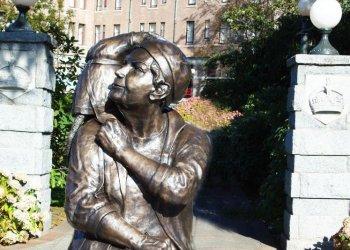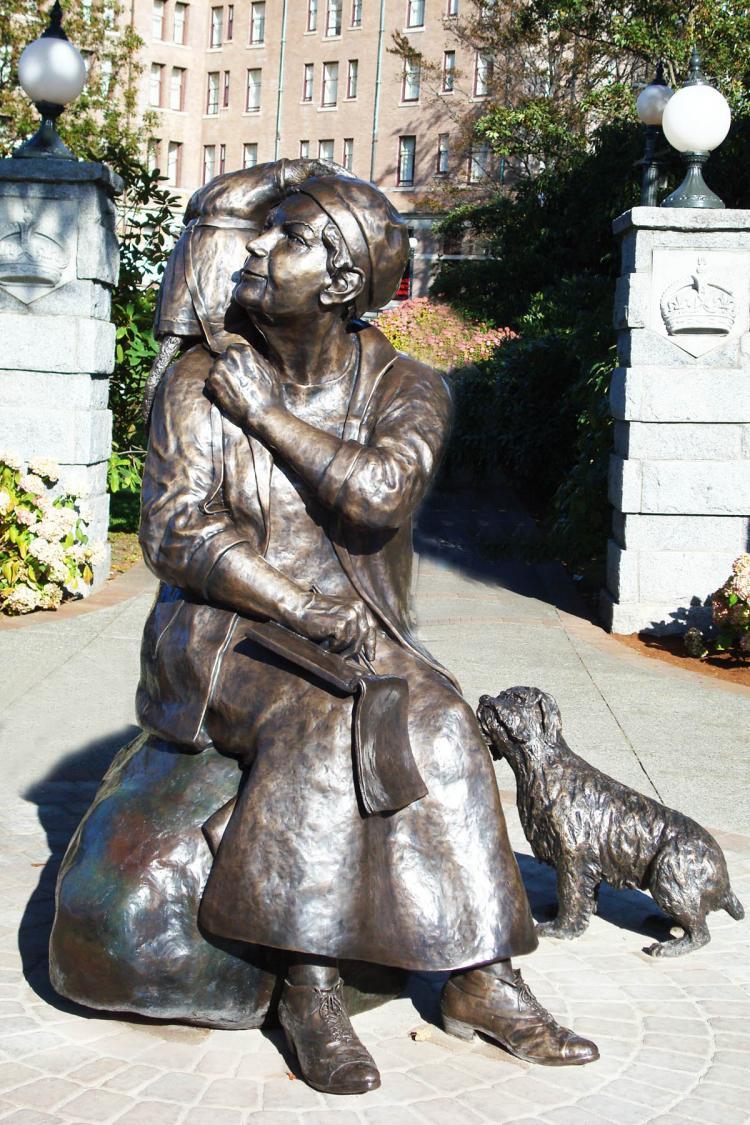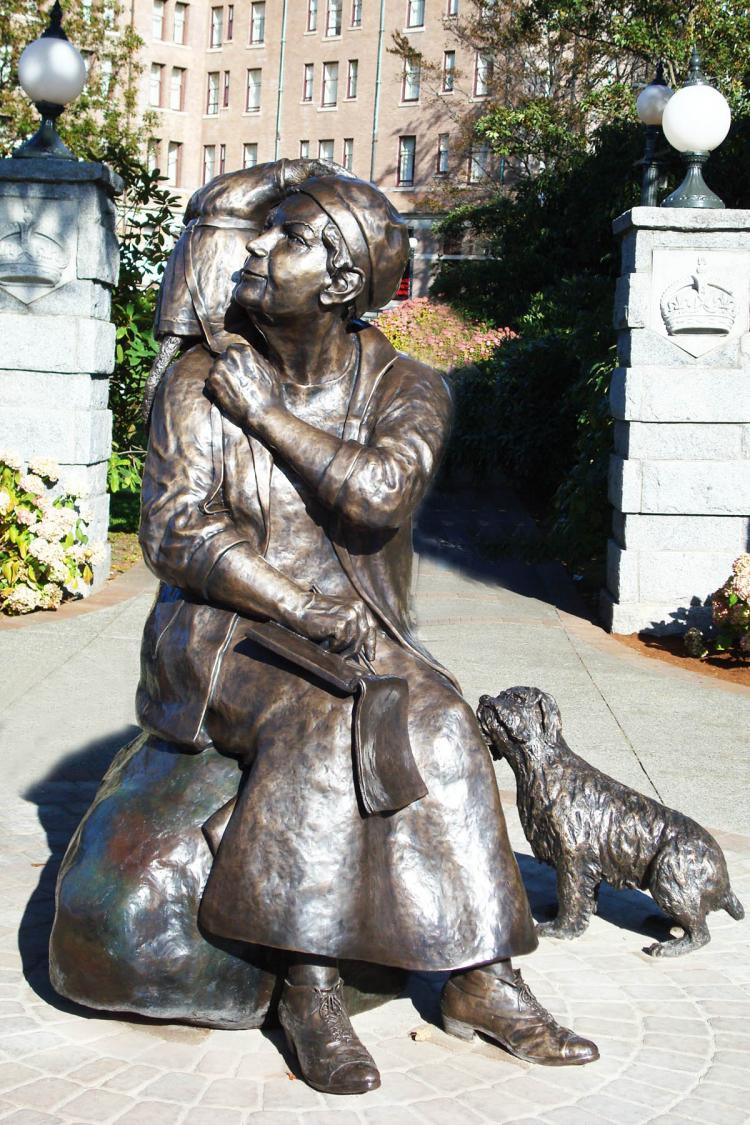One of Canada’s most beloved and eccentric artists has been given a permanent place of honour overlooking Victoria’s legislature buildings. A new statue commemorating the life of Emily Carr was unveiled Wednesday on a site donated by the Fairmont Empress hotel on the corner of Belleville and Government.
The larger-than-life bronze statue portrays the artist sitting on a rock, sketch pad in hand, surrounded by her loyal companions—her dog Billie and her pet monkey, Woo. The sculpture, which weighs over 300 kilograms, sits a few blocks from where Carr grew up in the James Bay district of Victoria.
Largely overlooked in her lifetime Carr’s work has garnered more recognition after her death with her paintings selling for upwards of $2,000,000.
Born Dec. 18, 1871 to English parents, Carr was the second youngest of six children. She enjoyed art from an early age and embarked on a serious study after her parents passed away. She attended the Westminster School of Art in London and also studied in San Francisco for two years.
Although she often traveled abroad, Carr always returned to Victoria where her work was largely underappreciated. Unable to sell her paintings, she opened a boarding house in the city which she ran for 15 years—a period in which she produced little work.
It wasn’t until 1927, when Carr was 57 years old, that she was asked to exhibit her work at the National Gallery of Canada as part of an exhibition on West Coast Aboriginal art. Carr’s work was well received and her talent was recognized by the Group of Seven, who at that time was made up of Canada’s most respected modern painters.
From this experience she gained a new mentor in the form of painter Lawren Harris, who encouraged her to focus on landscape painting. Reinvigorated, Carr went on to produce some of her most important work.
In addition to painting, Carr sculpted and wrote. Although she produced work in both of these fields she is best known for her oil on canvas paintings. The quintessential B.C. artist, Carr’s work can be divided into two main categories—Aboriginal culture of the past and landscapes of Canada’s West Coast. Inspired by the natural environment and the many abandoned First Nations villages on the B.C. coast, she produced the work that first brought her to the attention of the National Gallery of Canada.
Considered a “modern” painter Carr was one of the first artists to capture Canada in a post-impressionist style.
As her health suffered in later life, Carr turned her attention to writing and produced a body of work that brought her to the attention of a public that had largely ignored her paintings. Her book “Klee Wyck” won the Governor General’s award.
Carr died in Victoria in 1945 with little idea that she was to become a Canadian icon whose work would continue to receive acclaim many years after her death.
The project to honour Carr has been in the works for ten years and was largely funded from donations and a fundraising campaign by Victoria’s Parks and Recreation Foundation which raised $400,000.
The larger-than-life bronze statue portrays the artist sitting on a rock, sketch pad in hand, surrounded by her loyal companions—her dog Billie and her pet monkey, Woo. The sculpture, which weighs over 300 kilograms, sits a few blocks from where Carr grew up in the James Bay district of Victoria.
Largely overlooked in her lifetime Carr’s work has garnered more recognition after her death with her paintings selling for upwards of $2,000,000.
Born Dec. 18, 1871 to English parents, Carr was the second youngest of six children. She enjoyed art from an early age and embarked on a serious study after her parents passed away. She attended the Westminster School of Art in London and also studied in San Francisco for two years.
Although she often traveled abroad, Carr always returned to Victoria where her work was largely underappreciated. Unable to sell her paintings, she opened a boarding house in the city which she ran for 15 years—a period in which she produced little work.
It wasn’t until 1927, when Carr was 57 years old, that she was asked to exhibit her work at the National Gallery of Canada as part of an exhibition on West Coast Aboriginal art. Carr’s work was well received and her talent was recognized by the Group of Seven, who at that time was made up of Canada’s most respected modern painters.
From this experience she gained a new mentor in the form of painter Lawren Harris, who encouraged her to focus on landscape painting. Reinvigorated, Carr went on to produce some of her most important work.
In addition to painting, Carr sculpted and wrote. Although she produced work in both of these fields she is best known for her oil on canvas paintings. The quintessential B.C. artist, Carr’s work can be divided into two main categories—Aboriginal culture of the past and landscapes of Canada’s West Coast. Inspired by the natural environment and the many abandoned First Nations villages on the B.C. coast, she produced the work that first brought her to the attention of the National Gallery of Canada.
Considered a “modern” painter Carr was one of the first artists to capture Canada in a post-impressionist style.
As her health suffered in later life, Carr turned her attention to writing and produced a body of work that brought her to the attention of a public that had largely ignored her paintings. Her book “Klee Wyck” won the Governor General’s award.
Carr died in Victoria in 1945 with little idea that she was to become a Canadian icon whose work would continue to receive acclaim many years after her death.
The project to honour Carr has been in the works for ten years and was largely funded from donations and a fundraising campaign by Victoria’s Parks and Recreation Foundation which raised $400,000.







